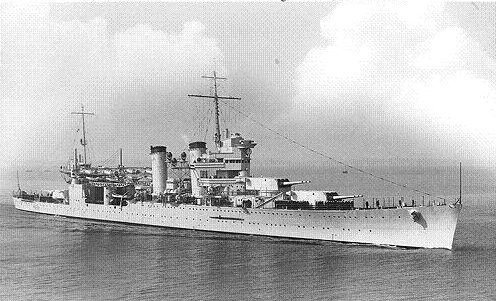![]() The Pacific War Online Encyclopedia
The Pacific War Online Encyclopedia
|
| Previous: Crowther, William A. | Table of Contents | Next: Crutchley, Victor A.C. |

Naval Historical Center #71787
Up to the end of the First World War, cruisers served as scouts for the main battle fleet, as commerce raiders or escorts, and to show the flag in distant colonies. Cruisers were somewhat larger than destroyers, were generally lightly armored, and were fast, with a speed of 30 knots or better. While the great naval powers were reluctant to send their battleships far from home waters, cruisers were considered more expendable. Because they were considerably less expensive than battleships, there was also less reluctance to expose cruisers to the wear and tear of constant patrolling. This made cruisers the original force projection platform.
For these roles, 6” (152mm) guns were perfectly adequate, and this was the standard cruiser armament. However, the British completed the first units of the Hawkins class, armed with 7.5" (190mm) guns, shortly after the end of the First World War. The disarmament treaties reflected this development by limiting non-capital ship gun caliber to 8” (203mm), and this became a new standard for cruiser armament. Ships whose guns met the older standard of 6” caliber became known as light cruisers, and those with the newer 8” standard caliber became known as heavy cruisers. With the lapse of the naval treaties and their limits on displacement, cruisers began to put on more armor protection, particularly in the U.S. Navy, whose cruisers began to resemble pocket battleships. Japanese heavy cruisers also had relatively heavy armor protection.
Another consequence of the disarmament treaties was to trade
weight of machinery for other considerations. Because fuel oil was not
included in the standard displacement, the treaties created an incentive
to optimize hull form for speed rather than cruising efficiency, since
this allowed greater weight of fuel to be traded for lighter machinery
(to propel the more efficient hull.)
The major naval powers built a number of battle cruisers before and
during the First World War, although those built by the United States
were not completed before the armistice, and were either broken up on
the ways or converted to aircraft
carriers under the terms of the naval disarmament treaties. Battle
cruisers had the heaviest possible armor and armament that could be put
on a fast ship (30 knots speed or better) with the technology of the
day. However, they proved vulnerable in engagements with the enemy
battle line and were overkill for the traditional cruiser missions.
Improvements in machinery and hull form had made it possible to build
fast battleships by the time of the Second World War. This made the
battle cruiser obsolete.
However, with the lapse of the naval disarmament treaties in the late 1930s, the U.S. Navy began studies of a three-tier family of cruisers. This eventually was realized as the Cleveland light cruisers, Baltimore heavy cruisers, and Alaska large cruisers. The Alaskas fit somewhere in the gap between heavy cruisers and battle cruisers, and never found a mission that could justify their considerable cost. The U.S. Navy also considered a very light cruiser design, of about 3000 tons, which would serve as a destroyer flotilla leader. It would carry up to three aircraft for scouting, and Friedman (2004) has concluded that its aircraft were the only real justification for a ship this size. The plans were dropped, and an unsuccessful experiment at equipping a few Fletcher class destroyers with aircraft was pursued instead.
For individual ship class listings, see the articles on large cruisers, heavy cruisers, and light cruisers.
References
The Pacific War Online Encyclopedia © 2007, 2009, 2011, 2014 by Kent G. Budge. Index